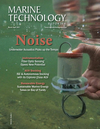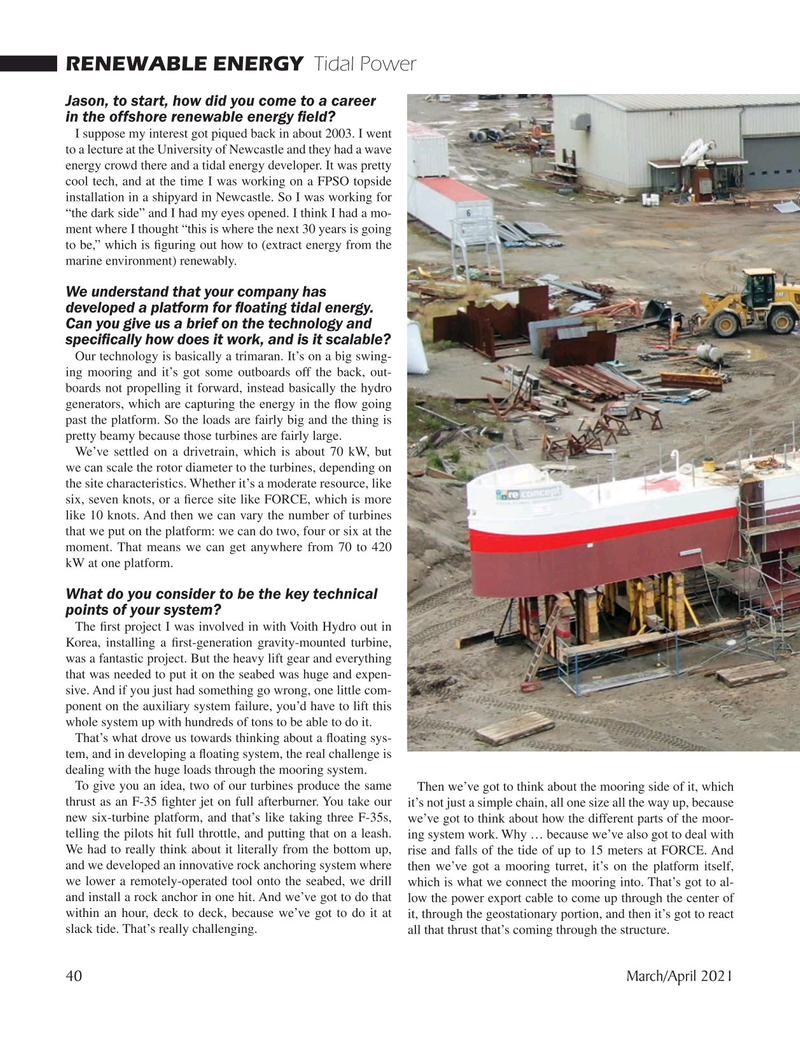
Page 40: of Marine Technology Magazine (March 2021)
Oceanographic Instrumentation & Sensors
Read this page in Pdf, Flash or Html5 edition of March 2021 Marine Technology Magazine
RENEWABLE ENERGY Tidal Power
Jason, to start, how did you come to a career in the offshore renewable energy ? eld?
I suppose my interest got piqued back in about 2003. I went to a lecture at the University of Newcastle and they had a wave energy crowd there and a tidal energy developer. It was pretty cool tech, and at the time I was working on a FPSO topside installation in a shipyard in Newcastle. So I was working for “the dark side” and I had my eyes opened. I think I had a mo- ment where I thought “this is where the next 30 years is going to be,” which is ? guring out how to (extract energy from the marine environment) renewably.
We understand that your company has developed a platform for ? oating tidal energy.
Can you give us a brief on the technology and speci? cally how does it work, and is it scalable?
Our technology is basically a trimaran. It’s on a big swing- ing mooring and it’s got some outboards off the back, out- boards not propelling it forward, instead basically the hydro generators, which are capturing the energy in the ? ow going past the platform. So the loads are fairly big and the thing is pretty beamy because those turbines are fairly large.
We’ve settled on a drivetrain, which is about 70 kW, but we can scale the rotor diameter to the turbines, depending on the site characteristics. Whether it’s a moderate resource, like six, seven knots, or a ? erce site like FORCE, which is more like 10 knots. And then we can vary the number of turbines that we put on the platform: we can do two, four or six at the moment. That means we can get anywhere from 70 to 420 kW at one platform.
What do you consider to be the key technical points of your system?
The ? rst project I was involved in with Voith Hydro out in
Korea, installing a ? rst-generation gravity-mounted turbine, was a fantastic project. But the heavy lift gear and everything that was needed to put it on the seabed was huge and expen- sive. And if you just had something go wrong, one little com- ponent on the auxiliary system failure, you’d have to lift this whole system up with hundreds of tons to be able to do it.
That’s what drove us towards thinking about a ? oating sys- tem, and in developing a ? oating system, the real challenge is dealing with the huge loads through the mooring system.
To give you an idea, two of our turbines produce the same Then we’ve got to think about the mooring side of it, which thrust as an F-35 ? ghter jet on full afterburner. You take our it’s not just a simple chain, all one size all the way up, because new six-turbine platform, and that’s like taking three F-35s, we’ve got to think about how the different parts of the moor- telling the pilots hit full throttle, and putting that on a leash. ing system work. Why … because we’ve also got to deal with
We had to really think about it literally from the bottom up, rise and falls of the tide of up to 15 meters at FORCE. And and we developed an innovative rock anchoring system where then we’ve got a mooring turret, it’s on the platform itself, we lower a remotely-operated tool onto the seabed, we drill which is what we connect the mooring into. That’s got to al- and install a rock anchor in one hit. And we’ve got to do that low the power export cable to come up through the center of within an hour, deck to deck, because we’ve got to do it at it, through the geostationary portion, and then it’s got to react slack tide. That’s really challenging. all that thrust that’s coming through the structure.
40 March/April 2021
MTR #3 (34-49).indd 40 3/22/2021 9:20:59 PM

 39
39

 41
41
